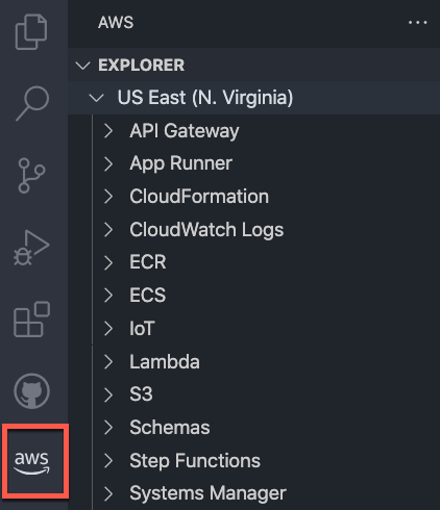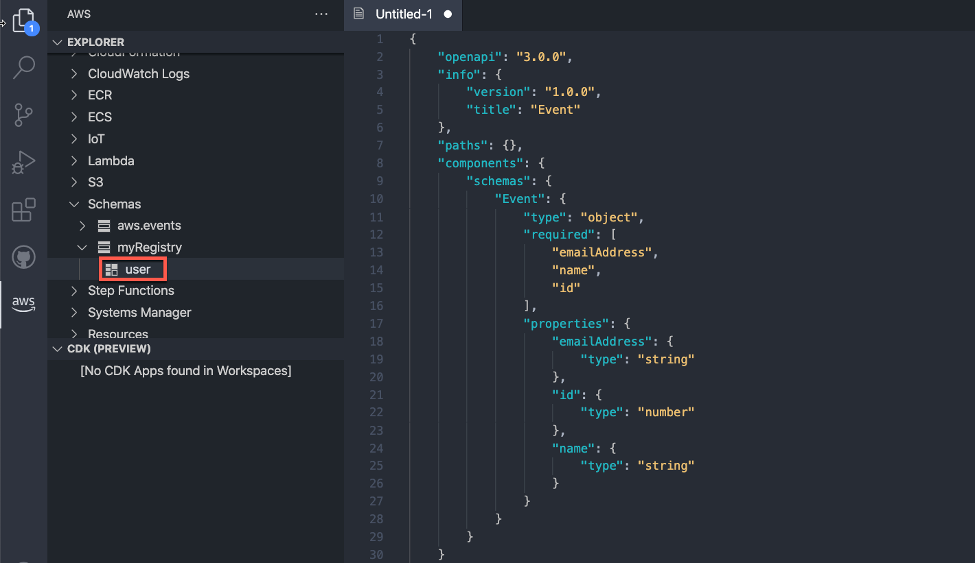Post Syndicated from Talia Nassi original https://aws.amazon.com/blogs/compute/working-with-events-and-amazon-eventbridge-schema-registry/
Event-driven architecture, at its core, is driven by producers creating events and subscribers being made aware of those events and acting upon them. An event is a data representation of something that happened elsewhere in the application or from an outside producer. When building event-driven applications, it is critical to determine what events exist in the application, who produces them, and who subscribes and react to them.
The first step in identifying these events is to work through the process of event discovery. In this process, you decide the events that the event source produces, and what parts of the application must know about those events. Events schemas describe the structure of an event and fields included in the event. If the event’s contents match the event target’s requirements, the service sends the event to the target. If you have an existing application that you want to discover event schemas automatically for you, can enable EventBridge schema discovery. If you are building a new application, you can conduct an event discovery exercise.
An event bus connects the event to the subscriber. The event bus at AWS is Amazon EventBridge. Use EventBridge to choreograph interactions between event sources and event targets.
In this post, you learn how to perform an event discovery exercise with your team. It shows how to create a schema registry with EventBridge, and how to represent the event as an object in your code to use in your application.
Event discovery
In the event discovery phase, all business stakeholders of an application come together and write down all the possible events that can happen. For example, possible events for an ecommerce application include: Account Created, Item added to cart, Order Placed. Write events in Noun + Past Tense Verb format.
| Events |
| Account Created |
| Item Added |
| Order Placed |
Notice that events are not technical or focused on implementation; rather they are real-world things that happened in your system. This is because everyone, from developers to product owners, must understand them. In the event discovery phase, events act as your business requirements. Later, developers then translate those requirements into code.
Once you have the events laid out, you decide who is interested in each event. For example, consider the events listed for the ecommerce application: Account Created, Item Added to cart, and Order Placed.
| Events | Subscribers |
| Account Created |
Marketing team Security team |
| Item Added | Inventory team |
| Order Placed | Fulfillment team |
Whenever a user creates an account, the marketing team subscribes to that event to send the account holder promotions. The security team encrypts the account holder’s user name and password into a database to save the account credentials. Whenever a user places an order, the system sends an email notification with the order details to stakeholders. The system also sends a message to the fulfillment team to start packing and shipping the order. This approach decouples the interactions between all of these services. This decoupling is beneficial because it increases developer independence by reducing the dependencies on other teams to write integrations.
Once the initial event schema planning is complete, you want to ensure that developers can continue to build new features without needing to coordinate with other teams closely on event schemas. For this reason, \EventBridge’s schema registry and automated schema discovery can help developers quickly build new features based on their application’s events.
You use EventBridge schema registries to search for, find, and track different schemas generated by your application. You can also automatically find schemas with the automated schema registry.
EventBridge schema registry and discovery
Applications can have many different types of events. Events generated from AWS services, third-party SaaS applications, and your custom applications.
With so many event sources, it can be challenging to know what to expect when consuming events. A schema represents the structure of an event. It describes what happened in the event, where the event came from, and the timestamp. The event schema is important for developers as it shows what data contained in the event, and allows them to write code based on that data.
For example, an Order Placed event might always contain a list of items in the order as an array, and a user ID as an integer. EventBridge helps automate the manual process of finding and documenting schemas. There are two capabilities to highlight: Schema registry and schema discovery.
A schema registry is a repository that stores a collection of schemas. You can use a schema registry to search for, find, and track different schemas used and generated by your application. AWS automatically stores schemas for all AWS sources for EventBridge in your schema registry. SaaS partner and custom schemas can be generated and added to the registry using the schema discovery feature. A schema registry enables you to use events as objects in your code more easily.
Adding an event to the EventBridge schema registry
In this tutorial, you create an Account Created event, which includes a user’s name and email address.
- Navigate to the Amazon EventBridge console and choose Schemas from the left panel.
 There are three types of schemas represented in the tabs: AWS event schema registry, discovered schema registry, and custom schema registry.When you choose AWS event schema registry, you can search for any AWS service or event that is supported by EventBridge. There, you can view the schema for that event.
There are three types of schemas represented in the tabs: AWS event schema registry, discovered schema registry, and custom schema registry.When you choose AWS event schema registry, you can search for any AWS service or event that is supported by EventBridge. There, you can view the schema for that event.

- To create a custom schema registry for your application, navigate to the custom schema registry tab and choose Create registry.

- Enter a name for the registry and then choose Create.

- There are currently no schemas in the registry. Choose Create custom schema to create one.

- Choose your registry as the destination and call the schema “user”. You can choose to load the schema template using an OpenAPI format from the Load Template option. You can then manually enter data for each of the fields.

- Alternatively, you can have the service discover the schema from JSON. Remember that events are written in JSON. Choose the Discover from JSON tab and enter the following code:
{"id": 1, "name": "Talia Nassi", "emailAddress": "[email protected]"}
- Choose Discover schema.

- EventBridge extrapolates the schema from this information. The schema shows that the ID is a number, the name is a string, and the email address is a string. Choose Create to create the schema.
- When you choose your schema from the schema registry, you can see the structure of the event you just created.

Representing events as objects in your code with code bindings
Once a schema is added to the registry, you can download a code binding, which allows you to represent the event as an object in your code. You can take advantage of IDE features such as validation and auto-complete. Code bindings are available for Java, Python, or TypeScript programming languages. You can download bindings from the Amazon EventBridge Console, or directly from your IDE with the AWS Toolkit plugin for IntelliJ and Visual Studio Code.
Choose the programming language you prefer, then choose Download. This downloads the code binding to your local machine.
You can also choose to download code bindings directly to your IDE with the AWS Toolkit. This tutorial uses VS Code but you can also use IntelliJ.
- Ensure you have VS Code installed.
- Navigate to the VS Code marketplace and search for AWS and install the AWS Toolkit. You may have to restart VS Code.

- Choose a profile to connect to AWS. Set the Region to the same Region that you created the schema in. You see this icon on the left panel when you access the AWS Explorer:

- Choose Schemas from the left panel, then choose your schema, myRegistry. Open user by right clicking and choosing View Schema.

- You can now use this event object in your code.
Conclusion
In this post, you learn about event discovery, schema registry, and schema discovery. Event discovery is essential when creating event-driven applications because it allows the team to see which events are created by your application, and who needs to subscribe to those events.
Events have specific structures, called schemas. Your schema registry includes all of the schemas for your events. You can use the schema registry to search for events produced by other teams, which can make development faster. You learn how to create a custom schema registry, and how to download code bindings to use events in your code.
For more information, visit Serverless Land.













